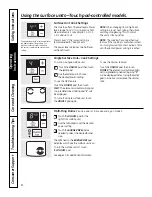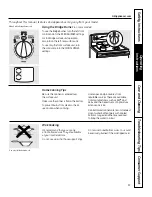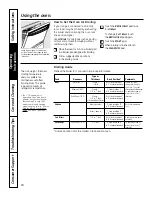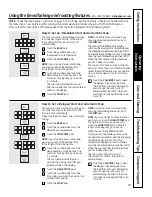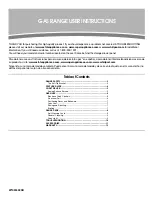
Safety Instructions
Operating Instructions
Safety Instructions
Operating
Instructions
Car
e and Cleaning
Tr
oubleshooting Tips
Consumer S
uppor
t
Selecting types of cookware
for glass cooktop models.
(on non-induction models)
GEAppliances.com
Stainless Steel:
recommended
Aluminum:
heavy weight recommended
Good conductivity. Aluminum residues
sometimes appear as scratches on the
cooktop but can be removed if cleaned
immediately. Because of its low melting
point, thin weight aluminum should not
be used.
Copper Bottom:
recommended
Copper may leave residues which can
appear as scratches. The residues can
be removed, as long as the cooktop is
cleaned immediately. However, do not let
these pots boil dry. Overheated metal can
bond to glass cooktops. An overheated
copper bottom pot will leave a residue
that will permanently stain the cooktop
if not removed immediately.
Porcelain Enamel on Cast Iron:
recommended if bottom of pan is coated
Porcelain Enamel on Steel:
not recommended
Heating empty pans can cause permanent
damage to cooktop glass. The enamel can
melt and bond to the ceramic cooktop.
Glass-ceramic:
not recommended
Poor performance. Will scratch the surface.
Stoneware:
not recommended
Poor performance. May scratch the
surface.
Cast Iron:
not recommended—unless designed
specifically for glass cooktops
Poor conductivity and slow to absorb heat.
Will scratch the cooktop surface.
Check pans for flat bottoms by using
a straight edge.
Pans with rounded, curved, ridged or
warped bottoms are not recommended.
The following information will help you choose cookware which will give good performance on glass cooktops.
See insert for cookware to use with induction cooktops.
For Best Results
■
Place only dry pans on the surface
elements. Do not place lids on the
surface elements, particularly wet lids.
■
Do not use woks that have support
rings. This type of wok will not heat
on glass surface elements.
■
We recommend that you use only a
flat-bottomed wok. They are available
at your local retail store. The bottom
of the wok should have the same
diameter as the surface element
to ensure proper contact.
■
Some special cooking procedures
require specific cookware such as
pressure cookers, deep-fat fryers, etc.
All cookware must have flat bottoms
and be the correct size.
■
Avoid allowing foods to boil dry
as some cookware may stick to the
cooking surface, causing permanent
damage to the cooktop.
Do not place wet pans
on the glass cooktop.
Do not use woks with support
rings on the glass cooktop.
Use flat-bottomed woks
on the glass cooktop.
NOTE
:
Follow all cookware manufacturer’s recommendations when using any type of
cookware on the ceramic cooktop.
7








